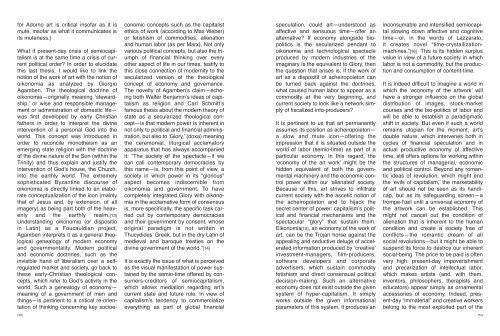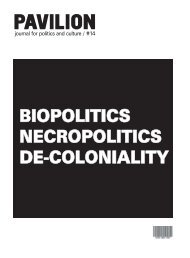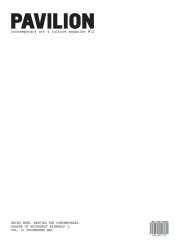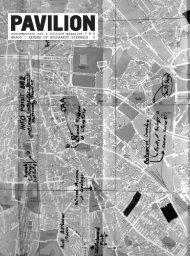Download pdf version of issue no. 16 (4 Mb) - Pavilion
Download pdf version of issue no. 16 (4 Mb) - Pavilion
Download pdf version of issue no. 16 (4 Mb) - Pavilion
You also want an ePaper? Increase the reach of your titles
YUMPU automatically turns print PDFs into web optimized ePapers that Google loves.
for Ador<strong>no</strong> art is critical ins<strong>of</strong>ar as it is<br />
mute, ins<strong>of</strong>ar as what it communicates is<br />
its muteness.)<br />
What if present-day crisis <strong>of</strong> semiocapitalism<br />
is at the same time a crisis <strong>of</strong> current<br />
political order? In order to elucidate<br />
this last thesis, I would like to link the<br />
<strong>no</strong>tion <strong>of</strong> the work <strong>of</strong> art with the <strong>no</strong>tion <strong>of</strong><br />
oiko<strong>no</strong>mia as analyzed by Giorgio<br />
Agamben. The theological doctrine <strong>of</strong><br />
oiko<strong>no</strong>mia—originally meaning ‘stewardship,’<br />
or wise and responsible management<br />
or administration <strong>of</strong> domestic life—<br />
was first developed by early Christian<br />
fathers in order to interpret the divine<br />
intervention <strong>of</strong> a personal God into the<br />
world. This concept was introduced in<br />
order to reconcile mo<strong>no</strong>theism as an<br />
emerging state religion with the doctrine<br />
<strong>of</strong> the divine nature <strong>of</strong> the Son (within the<br />
Trinity) and thus explain and justify the<br />
intervention <strong>of</strong> God’s house, the Church,<br />
into the earthly world. The extremely<br />
sophisticated Byzantine discourse <strong>of</strong><br />
oiko<strong>no</strong>mia is directly linked to an elaborate<br />
conceptualization <strong>of</strong> the icon (mainly<br />
that <strong>of</strong> Jesus and, by extension, <strong>of</strong> all<br />
imagery) as being part both <strong>of</strong> the heavenly<br />
and the earthly realm.[13]<br />
Understanding oiko<strong>no</strong>mia (or dispositio<br />
in Latin) as a Foucauldian project,<br />
Agamben interprets it as a general theological<br />
genealogy <strong>of</strong> modern eco<strong>no</strong>my<br />
and governmentality. Modern political<br />
and eco<strong>no</strong>mic doctrines, such as the<br />
invisible hand <strong>of</strong> liberalism over a selfregulated<br />
market and society, go back to<br />
these early-Christian theological concepts,<br />
which refer to God’s activity in the<br />
world. Such a genealogy <strong>of</strong> eco<strong>no</strong>my—<br />
meaning <strong>of</strong> a government <strong>of</strong> men and<br />
things—is pertinent to a critical re-orientation<br />
<strong>of</strong> thinking concerning key socioe-<br />
co<strong>no</strong>mic concepts such as the capitalist<br />
ethics <strong>of</strong> work (according to Max Weber)<br />
or fetishism <strong>of</strong> commodities, alienation<br />
and human labor (as per Marx). Not only<br />
various political concepts, but also the triumph<br />
<strong>of</strong> financial thinking over every<br />
other aspect <strong>of</strong> life in our times, testify to<br />
this close connection <strong>of</strong> modernity to the<br />
secularized <strong>version</strong> <strong>of</strong> the theological<br />
concept <strong>of</strong> eco<strong>no</strong>my and governance.<br />
The <strong>no</strong>velty <strong>of</strong> Agamben’s claim—echoing<br />
both Walter Benjamin’s ideas <strong>of</strong> capitalism<br />
as religion and Carl Schmitt’s<br />
famous thesis about the modern theory <strong>of</strong><br />
state as a secularized theological concept—is<br />
that modern power is inherent in<br />
<strong>no</strong>t only to political and financial administration,<br />
but also to ‘Glory,’ (doxa) meaning<br />
the ceremonial, liturgical acclamatory<br />
apparatus that has always accompanied<br />
it: “The society <strong>of</strong> the spectacle—if we<br />
can call contemporary democracies by<br />
this name—is, from this point <strong>of</strong> view, a<br />
society in which power in its “glorious”<br />
aspect becomes indiscernible from<br />
oiko<strong>no</strong>mia and government. To have<br />
completely integrated Glory with oiko<strong>no</strong>mia<br />
in the acclamative form <strong>of</strong> consensus<br />
is, more specifically, the specific task carried<br />
out by contemporary democracies<br />
and their government by consent, whose<br />
original paradigm is <strong>no</strong>t written in<br />
Thucydides’ Greek, but in the dry Latin <strong>of</strong><br />
medieval and baroque treaties on the<br />
divine government <strong>of</strong> the world.”[14]<br />
It is exactly the <strong>issue</strong> <strong>of</strong> what is perceived<br />
as the visual manifestation <strong>of</strong> power sustained<br />
by the semio-time <strong>of</strong>fered by consumers-creditors<br />
<strong>of</strong> semiocapitalism,<br />
which allows mediation regarding art’s<br />
current state and future role. In view <strong>of</strong><br />
capitalism’s tendency to commercialize<br />
everything as part <strong>of</strong> global financial<br />
speculation, could art—understood as<br />
affective and sensuous time—<strong>of</strong>fer an<br />
alternative? If eco<strong>no</strong>my alongside biopolitics<br />
is the secularized pendant to<br />
oiko<strong>no</strong>mia and tech<strong>no</strong>logical spectacle<br />
produced by modern industries <strong>of</strong> the<br />
imaginary is the equivalent to Glory, then<br />
the question that arises is: If the work <strong>of</strong><br />
art as a dispositif <strong>of</strong> acheiropoieton can<br />
be turned back against the doctrines,<br />
what caused human labor to appear as a<br />
commodity at the very beginning, and<br />
current society to look like a network simply<br />
<strong>of</strong> fiscalized info-producers?<br />
It is pertinent to us that art permanently<br />
assumes its position as acheiropoieton—<br />
a slow and mute icon—<strong>of</strong>fering the<br />
impression that it is situated outside the<br />
world <strong>of</strong> labor (semio-time) as part <strong>of</strong> a<br />
particular eco<strong>no</strong>my. In this regard, the<br />
‘eco<strong>no</strong>my <strong>of</strong> the art work’ might be the<br />
hidden equivalent <strong>of</strong> both the governmental<br />
machinery and the eco<strong>no</strong>mic control<br />
power within our ‘alienated’ society.<br />
Because <strong>of</strong> this, art strives to infiltrate<br />
current society with the ascetic <strong>no</strong>tion <strong>of</strong><br />
the acheiropoieton and to hijack the<br />
secret center <strong>of</strong> power: capitalism’s political<br />
and financial mechanisms and the<br />
spectacular “glory” that sustain them.<br />
Eiko<strong>no</strong>mia[15], an eco<strong>no</strong>my <strong>of</strong> the work <strong>of</strong><br />
art, can be the Trojan horse against the<br />
appealing and seductive deluge <strong>of</strong> accelerated<br />
information produced by ‘creative’<br />
investment-managers, film-producers,<br />
s<strong>of</strong>tware developers and corporate<br />
advertisers, which sustain commodity<br />
fetishism and direct consensual political<br />
decision-making. Such an alternative<br />
eco<strong>no</strong>my does <strong>no</strong>t exist outside the given<br />
system <strong>of</strong> hyper-capitalism. It simply<br />
works outside the given informational<br />
parameters <strong>of</strong> this system. It produces an<br />
inconsumable and intensified semiocapital<br />
slowing down affective and cognitive<br />
time—or, in the words <strong>of</strong> Lazzarato,<br />
it creates <strong>no</strong>vel “time-crystallizationmachines.”[<strong>16</strong>]<br />
This is its hidden surplus<br />
value in view <strong>of</strong> a future society in which<br />
labor is <strong>no</strong>t a commodity, but the production<br />
and consumption <strong>of</strong> content-time.<br />
It is indeed difficult to imagine a world in<br />
which the ‘eco<strong>no</strong>my <strong>of</strong> the artwork’ will<br />
have a stronger influence on the global<br />
distribution <strong>of</strong> images, stock-market<br />
courses and the bio-politics <strong>of</strong> labor and<br />
will be able to establish a paradigmatic<br />
shift in society. But even if such a world<br />
remains utopian for the moment, art’s<br />
double nature, which intervenes both in<br />
cycles <strong>of</strong> financial speculation and in<br />
actual productive eco<strong>no</strong>my <strong>of</strong> affective<br />
time, still <strong>of</strong>fers options for working within<br />
the structures <strong>of</strong> managerial, eco<strong>no</strong>mic<br />
and political control. Beyond any romantic<br />
ideas <strong>of</strong> revolution, which might end<br />
the ‘evils <strong>of</strong> capitalism,’ the marketability<br />
<strong>of</strong> art should <strong>no</strong>t be seen as its handicap,<br />
but as its safeguarding screen—a<br />
trompe-l'œil until a universal eco<strong>no</strong>my <strong>of</strong><br />
the artwork can be established. This<br />
might <strong>no</strong>t cancel out the condition <strong>of</strong><br />
alienation that is inherent to the human<br />
condition and create a society free <strong>of</strong><br />
conflicts—the romantic dream <strong>of</strong> all<br />
social revolutions—but it might be able to<br />
suspend its force to destroy our inherent<br />
social-being. The price to be paid is <strong>of</strong>ten<br />
very high: present-day impoverishment<br />
and precarization <strong>of</strong> intellectual labor,<br />
which makes artists (and, with them,<br />
inventors, philosophers, therapists and<br />
educators) appear simply as ornamental<br />
accessories <strong>of</strong> eco<strong>no</strong>my. Indeed, present-day<br />
“immaterial” and creative workers<br />
belong to the most exploited part <strong>of</strong> the<br />
[50] [51]








